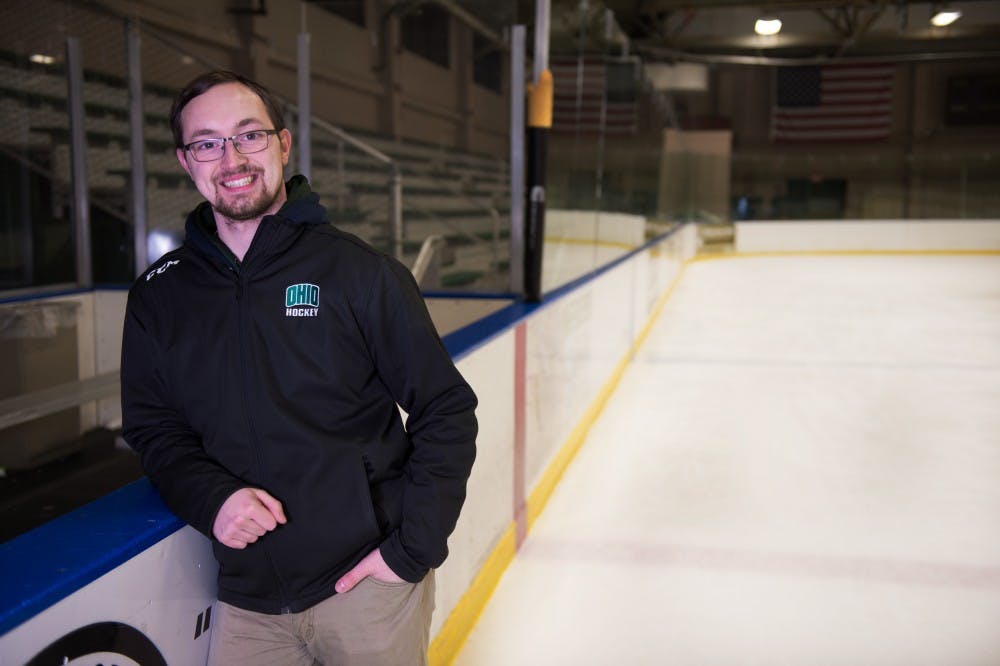Standing on the Ohio bench, arms folded across a black Ohio Hockey jacket, Reese Hayes scans the chaos unfolding on the ice.
He’s not concerned with the Bobcats’ forecheck, shot blocking or outlet passes. It’s their big hits and hard falls that catch his eye.
When players come off the ice looking dazed, wincing in pain or holding a limb, Hayes is the person they can’t hide it from.
“He makes sure that we’re safe,” defenseman Jake Faiella said.
Hayes, a 23-year-old from Tacoma, Washington, studying athletic training in Ohio’s graduate program, is the Bobcats’ athletic trainer. He is the authority on team injuries and the availability of injured players.
In four years studying athletic training as an undergraduate at Eastern Washington University, Hayes worked with Division I teams such as track and field, men’s basketball and football.
He chose Ohio after considering schools all over the country from West Virginia to University of Nevada, Las Vegas. Hayes didn’t visit Athens before making his decision, but he looked online at pictures and maps of the school and surrounding area.
This season is Hayes’s first working with a hockey team. He still worries about slipping every time he steps on the ice.
“I made a joke to my (student assistants) that on the (Oct. 21 game versus Jamestown) that was on ESPN3, if I slipped on the ice you would see me on SportsCenter as one of the Not Top 10 Plays,” he said.
Every day, Hayes goes to Bird Arena about an hour and a half before practice, evaluates players and sends Ohio coach Sean Hogan an injury report. Players listed as “limited” practice in red, no-contact jerseys. Players listed as “out” don’t practice at all.
Hogan, understandably, wants as many players as possible available for practices and games. But if Hayes sees a reason to keep a player on the sideline, his word is final.
“You don’t argue,” Hogan said.
Sometimes Hayes’s injury reports have to come on the fly during games when there is little time to make a decision before Hogan might want to send the player in question back out to play.
If Hayes sees a potentially injured player, he makes his way down the bench to ensure the player is OK to go out for the next shift.
“Hey, how are you feeling?” he’ll say. “Don’t lie to me.”
In a game at Iowa State in mid-November, freshman forward Pat Hannan came off the ice shaken up and Hayes made his decision in a matter of minutes — Hannan would not return. It made for a juggling act of the lines, but Hogan knows it was for the best.
“I trust him,” Hogan said. “He knows more about that stuff than I do. His interests are our interests.”
Faiella, in several years of playing competitive hockey, has seen a broad range of trainers: some want players out for weeks at the first sign of pain, while others downplay concussion symptoms to keep players on the ice.
Hayes falls somewhere in the middle of that spectrum, Faiella said. And the middle is where any trainer should want to be.
“Really just not overbearing on the players,” Faiella said of Hayes. “That’s why I think the players like him a lot.”
Hayes is readily available to players before and after practice, in case they need an evaluation.
“Me, he’s always evaluating me,” Faiella, who deals with consistent back problems, said. “But there’s other guys who may not see him for weeks at a time.”
Faiella’s standard meeting with Hayes lasts 15-20 minutes and includes stretching, discussion about diet and instructions for physical therapy at home and activities at the gym.
The diet tips have nothing to do with Faiella’s back problems, but Hayes “covers everything,” Faiella said.
But, one constant concern across all sports is concussions. Though Hayes said there isn’t one exact way to determine if a player is concussed, there is a standard method to measure an individual’s risk.
He uses a test called Sport Concussion Assessment Tool – 3rd Edition (SCAT3), which combines the assessment of cognitive and neurological function, balance and memory. Concussed players go through a “return to play protocol,” Hayes said, in which they are eased back into full practice through increasingly intensive biking, skating and drills.
Knowing when players are ready to return to play is a concept of great interest to Hayes, which is why his final graduate research project will seek to measure and evaluate when athletes are ready to return from ACL injuries.
After another year of schooling and working with Ohio’s hockey team, Hayes hopes to begin a career as an athletic trainer at the collegiate level. He said he doesn’t have a particular sport in mind, but hockey, which hadn’t previously been on his radar, is a sport he enjoys.
He knows how to interact with the players and they respect him. Aside from occasionally downplaying how much pain they’re in, players have been open with Hayes about their injuries.
The most gruesome injury Hayes has witnessed was when an Eastern Washington football player dislocated his elbow. Ohio’s season so far has been “pretty tame” in comparison, he said.
But his job has its challenges. Hayes tries to keep players happy and in the lineup while ensuring their safety and preventing more serious injuries.
“It’s a big responsibility,” he said. “Sometimes you have guys playing when they’re injured or they’re hurt a little bit. It’s kind of a balance that I have to go through.”






